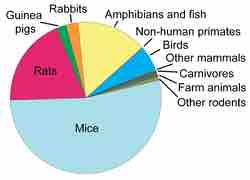Controversies in Animal Testing
The use of animals in research is a very controversial topic in today's scientific community. While animal research was once common and unquestioned, it now raises an important ethical issue: is it ethical to harm animals with the aim of improving human lives? An experiment's design and application must be ethical whether the research subjects are humans or animals, but how "ethical" is defined across species is the subject of much debate.
A key difference between an animal and a human is that animals cannot provide informed consent to participate in an experiment because they cannot understand the risks or consequences of the experiment. While a person can consent to participate in research after being informed of an experiment's goals and methods (and in fact this is a mandatory guideline for ethical research among humans), this is not possible for animals, which raises complicated questions about ethics.
The Animal Rights Debate
Two main questions about the ethics of animal testing are whether animals have rights and, if they do, whether those rights should be protected. A legal right is a law-based entitlement that applies to all members of a particular group and is upheld by the justice system. Those in favor of extending equal rights to animals argue that the suffering and well-being of other species are just as important as the suffering and well-being of humans and should be treated accordingly. It is known that animals can feel pain and distress, and therefore many consider the act of subjecting animals to pain, injury, or death for the sake of science to be immoral.
Others argue against extending equal rights to animals, positing that human interest should be placed above the well-being of animals. Many argue that animal research has yielded substantial benefits to the human race, and that these outweigh the negative effects on animals.
Current Animal Research
The Animal Welfare Act (AWA) of 1966 is the only federal law in the United States regulating the treatment of animals in research; while some other laws and policies may include additional species coverage or specifications for animal care and use, all refer to the AWA as the minimally acceptable standard for animal treatment and care. Some of the animals covered under the AWA include any live or dead cat, dog, hamster, rabbit, nonhuman primate, or guinea pig. Animals excluded from this act are birds, rats, mice, farm animals, and cold-blooded animals.
Under the AWA, all animal dealers must be registered and licensed, and all animal testing facilities in compliance with this act are required to establish a special committee that includes at least one person trained as a veterinarian and one person who is not affiliated with the facility. These committees regularly assess animal care, treatment, and practices during research. In addition to compliance with the Animal Welfare Act, most research institutions have an institutional review board (IRB), which is a committee that has been formally designated to approve, monitor, and review biomedical and behavioral research involving humans. Most studies involving humans must pass IRB approval before they can begin.
A variety of animals are used in experiments. While animals with shorter life spans and less sophisticated nervous systems tend to be used, this is not always true. Some advocate that there should be a hierarchy of animal rights, with more rights granted to sophisticated species, while others argue that the same rights should be awarded to all living beings.

Animal Testing by the Numbers
The proportion of animals used in research testing in Europe in 2005. Mice and rats were the most frequently used animals.
Replacement, Reduction, and Refinement
Replacement, reduction, and refinement (also referred to as "the three Rs") exist as guiding principles for more ethical use of animals in testing and research. These guidelines are intended to improve animal welfare and scientific quality where the use of animals in experimentation cannot be avoided and are implemented in many research labs worldwide. Replacement refers to the preferred use of non-animal methods whenever it is possible to achieve the same scientific goals as animal research. Reduction refers to methods that enable researchers to obtain comparable levels of information from fewer animals, or to obtain more information from the same number of animals. Methods of experimental refinement aim to alleviate or minimize potential pain, suffering, or distress and enhance the welfare of the animals used.